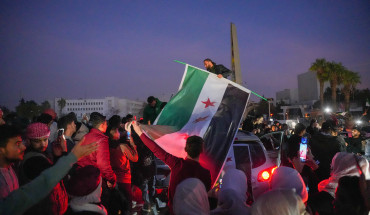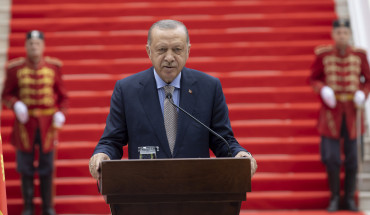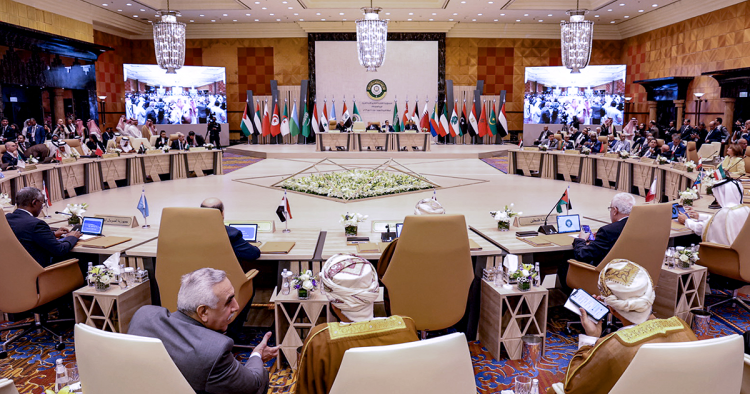The Middle East is experiencing a remarkable spate of diplomacy, de-escalation, and normalization. This started with the Abraham Accords between Israel and four Arab countries in 2020, the ending of the intra-Gulf Cooperation Council (GCC) crisis in 2021, and the revival of GCC-Turkey relations, and has extended to the Saudi-Iranian agreement in March and the recent readmission of Syria’s Bashar al-Assad into the Arab League. This comes after a decade of escalation when key Middle East states — even those within the GCC — fought proxy political and sometimes armed contests over influence throughout the region, from Libya to Yemen.
This turn to negotiation and de-escalation is generally a positive development, as the region needs to take charge of its own destiny and should focus on ways to deescalate and resolve conflicts rather than initiate and escalate them. But normalization and de-escalation does not always lead to meaningful conflict resolution and lasting problem solving; indeed, sometimes the reverse is true. What needs to be done so that this positive momentum for de-escalation can be the first phase of a more meaningful set of engagements to build a more lasting regional peace and integration?
Drivers of de-escalation
This flurry of regional diplomacy has a number of causes. First, it is the result of the growing self-confidence of key states in the Middle East and their leaders, and their realization that the U.S. is no longer willing or able to solve their problems for them — e.g., the Arab-Israeli conflict, the conflict with Iran, the conflict in Syria — and that they have to take regional matters into their own hands. Second, it is the result of an acute shift of approach in Saudi Arabia, from the early overconfidence in confrontation — in Yemen, toward Qatar, etc. — to an equally rapid shift toward negotiation and de-escalation. Third, it is the result of a surmise among many leaders in the region that the approaches of escalating conflict with adversaries, or simply isolating and not engaging with them, have not borne fruit; so why not try the third alternative of engagement and negotiation?
Abrahamic accord and discord
The Abraham Accords, driven by the UAE but tacitly approved by Saudi Arabia, remain the largest sea change in the region. The Accords were largely driven by bilateral interests among the signatories and open up important areas of cooperation in terms of trade, investment, technology, defense, tourism, and so on. With the Abrahamic Family House launched in Abu Dhabi, these Accords have also made the important contribution of trying to repair and rebuild Muslim-Jewish-Christian faith relations, which are centuries old, and trying to separate them from the still ongoing conflict in Israel-Palestine.
The obvious risk of normalization without significant progress in the Israeli-Palestinian arena has already come to pass. Barely three years after the Accords, Israel now has the most right-wing government in its history and is taking more aggressive actions against Palestinians. This is not dissimilar to the pattern that emerged after the 1979 peace with Egypt: Israel pocketed that peace, and with Egypt out of the military equation, proceeded with a full-scale colonization process in the West Bank. For the Accords to contribute to lasting peace and stability in the region, both sides to the Accords, as well as the U.S. and other great powers, should use the new relationships and dynamics that have been engendered by them to forge a viable path forward for Israelis and Palestinians to coexist in security, self-respect, and prosperity, whether that is in some form of two-state solution, or some form of decentralized and binational one-state solution.
Short-term de-risking with Iran
With Iran, the turn toward engagement, negotiation, and restoration of normal relations could indeed pay valuable dividends. The geopolitical contests between Iran and Saudi Arabia, raging since 1979, led to a violent escalation of communal tensions between Sunnis and Shiites throughout the region — in Iraq, Syria, Lebanon, Yemen, Bahrain, and even Iran and Saudi Arabia. A simple return to cordial relations — including the scenes of warmth and amity between Saudis and Iranians as the former helped evacuate the latter from Sudan — sends an important message to sectarian communities throughout the region.
Second, the normalization of relations between Saudi Arabia and Iran is important to help deescalate proxy conflicts. In Yemen, the improvement of relations has already paid valuable dividends; it is helping solidify a long-term cease-fire, opening up new channels for humanitarian and economic aid, and reviving the possibility of peace talks among the warring factions. In Iraq and Lebanon, the Saudi-Iranian rapprochement also provides opportunities for progress; both Iraq and Lebanon have suffered from the sectarian polarization thrown out by the Saudi-Iranian conflict, and both have fairly inclusive (although very dysfunctional) political structures that could build on more cooperative relations between the two regional powers. The same conditions do not apply in Syria, where the regime has closed any path toward an inclusive way forward, but more on that later.
At one minimal level, the Saudi-Iranian normalization can be seen as expressing a Saudi need to stop Houthi attacks on Saudi Arabia with Iranian-supplied drones and missiles, and to get out of the way of any potential Israeli-Iranian or Israeli-American-Iranian conflict over Iran’s continuing nuclear program. And for Iran, it expresses an urgent need to reduce its political and economic isolation and improve relations in its Arab near-abroad, at a time when relations with both the U.S. and Europe are at a low.
But like in the Abraham Accords, for the normalization breakthrough to have a deeper and more lasting stabilizing effect will require a new line of negotiation and effort to build on the positives, and will require awareness of the inbuilt risks of some aspects of normalization. The risk, of course, is that the rapid normalization could be read by leaders in Tehran as vindication of their decades of intervention and militia-building in Lebanon, Iraq, Syria, and Yemen, and encouragement to double down on that strategy; it could also be read as regional acquiescence — or at least, nonchalance — about the brutal repression of their own people at home, and a spur to double down on that repression as well.
I would hope that the normalization with Saudi Arabia would send a different signal to at least some in Tehran: that an alternative way forward is possible with the Arab world, one not built on suspicion and fear, but rather on mutual cooperation — a more stable and integrated state-based regional order in which security and economic benefits are produced not by backing rival militias here and there, but rather by stable and long-term cooperation with states in the region.
From the Saudi side, the possible limited ambitions of the normalization (stopping Houthi attacks and avoiding getting caught up in an Israeli-Iranian exchange of fire) are understandable. But Saudi Arabia should also use its engagement with Iran to push for a more lasting and meaningful stability. It should make clear to Tehran that while relations with the U.S. are cool, Riyadh shares the international concerns about Iran’s nuclear program. Riyadh itself wants to build 17 nuclear reactors, for civilian use, and can offer many ways in which the countries of the region could cooperate on civilian nuclear development. Riyadh should also make it clear that an Iranian nuclear weapon will push Saudi Arabia in the same direction, and that is an outcome that neither Tehran nor Riyadh wants.
Saudi Arabia and Iran should also engage on the long term, or final status, in the region. For the immediate future, Iran will still have major proxy militia forces in Lebanon, Syria, Iraq, and Yemen; and Saudi Arabia will still be militarily engaged on the side of the government in Yemen. But this system of proxy fighting that took root over the past few decades has to be eventually dismantled. Both Iran and Saudi Arabia have legitimate security concerns that they should discuss and address; and surely other powers will need to be part of that discussion as well. But these major regional powers, needing to build a more stable regional environment in which their populations can thrive over the coming decades, will require serious discussion about how to end civil wars, disband militias — proxy or otherwise — and build inclusive, stable states that could be part of the solution, not the problem, in the next decades.
The moral and political hazard of Syria
And this brings us to the problem of Syria. Beyond the moral shock of seeing such a murderous regime being rehabilitated, one can perhaps perceive the realpolitik logic of those Arab states engaging with the Assad regime: attempts to defeat the regime through conflict failed; years of isolation that ensued also failed to change regime behavior or improve conditions for the Syrian people; so perhaps engagement can bring about a different outcome.
The risk, again, is obvious: that the regime will conclude — which it probably already has — that the years-long policy of resisting any political compromise and using extreme brutality against its own people has paid off and should remain a pillar of its domestic strategy. It could also conclude that promoting the drug trade through the mass production and export of Captagon to neighboring Arab states has been among its most successful strategies and should remain part of its regional leverage. Finally, the regime could conclude that the allies it chose — Iran and Russia — are now being rehabilitated in the region as well, and hence it should stick with them.
But these convictions generated by the normalization run exactly counter to what Arab diplomats hope to achieve through engagement with the Assad regime: a crackdown on drug production and trade, the revival of an internal political process; the release of detainees and the reduction of regime brutality; a return of refugees and internally displaced persons that the regime participated in displacing in the first place; and a distancing of the regime from Iran. Many of the stated goals of Arab interlocutors with the Assad regime are desperately needed for a population that has not only been acutely suffering for the past decade, but also sees no light at the end of the tunnel. Now that a majority of Arab states have decided on engagement and normalization, after the previous two approaches of conflict and isolation failed, one would hope that they will use all the levers at their disposal to push for some real benefits for the Syrian people, including urgent humanitarian relief, release of detainees, and the like. But the engaged Arab states should also push hard to revive a political process for a more inclusive Syrian government or political pact. That means reaching out to the opposition and engaging with Syrians of all stripes to help bring about a more inclusive and stable long-term result. The current Assad regime, if rehabilitated as is, without any significant change or reform, will simply perpetuate and generate more suffering, conflict, and instability in the years ahead.
Building toward more robust peacebuilding
In conclusion, there is much to understand, and a considerable amount to commend, in the recent spate of regional diplomacy in the Middle East. It is high time that the states and leaders in the region take charge of its long-term fate rather than leave it to outside great powers of one stripe or another. It is also commendable to bring diplomacy and engagement back to the forefront after decades of conflict — either direct or proxy — and “I won’t talk to my adversary” approaches. The people of the Middle East certainly need a more peaceful, integrated, and cooperative region if they are to weather the socio-economic, health, and environmental challenges of the decades ahead. It is well known that war is the continuation of politics by other means; and while politics and diplomacy are a promising way forward, one should also be aware that they are often the continuation of war by other means. Regional leaders should be encouraged to use this new round of diplomacy not to paper over conflicts, but rather as a starting point to do the hard work of addressing the real long-term drivers of conflict in the region.
Paul Salem is president and CEO of the Middle East Institute. He focuses on issues of political change, transition, and conflict as well as the regional and international relations of the Middle East.
Photo by AFP via Getty Images
The Middle East Institute (MEI) is an independent, non-partisan, non-for-profit, educational organization. It does not engage in advocacy and its scholars’ opinions are their own. MEI welcomes financial donations, but retains sole editorial control over its work and its publications reflect only the authors’ views. For a listing of MEI donors, please click here.












